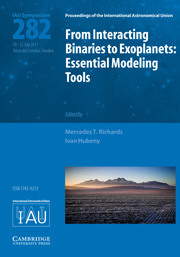Description
From Interacting Binaries to Exoplanets (IAU S282)
Essential Modeling Tools
Proceedings of the International Astronomical Union Symposia and Colloquia Series
Coordinators: Richards Mercedes T., Hubeny Ivan
In-depth summary and discussion of the state-of-the-art techniques used to study stars, brown dwarfs and exoplanets in multiple-object systems.
Language: English
Subject for From Interacting Binaries to Exoplanets (IAU S282):
Publication date: 05-2012
600 p. · 17.8x25.3 cm · Hardback
600 p. · 17.8x25.3 cm · Hardback
Description
/li>Contents
/li>
In IAU Symposium 282, members of the exoplanet and binary star communities unite for the first time to discuss the state-of-the-art discovery, imaging, modeling and analysis tools used to study stars, brown dwarfs and exoplanets in multiple-object systems. They describe detection techniques using advanced telescopes and detectors, including the Kepler mission and the proposed Gaia and LSST projects. Imaging techniques discussed include adaptive optics, interferometry, polarimetry and tomography, while key modeling tools are covered in detail. Other topics include simulations of formation mechanisms in binary star systems, non-conservative evolution of binary stars, the formation and evolution of planets and a theory for the structure, atmospheres and evolution of giant exoplanets. The volume concludes with hydrodynamic simulations, models of planetary atmospheres and the habitability of exoplanets. These proceedings demonstrate how sophisticated modeling codes bridge the gap between theory and observations and increase our understanding of binary and multiple systems.
Preface; 1. Multiwavelength photometry and spectroscopy of interacting binaries; 2. Observations and analysis of exoplanets and brown dwarfs; 3. Imaging techniques; 4. Model atmospheres of stars, interacting binaries, disks, exoplanets, and brown dwarfs; 5. Synthetic light curves and velocity curves, synthetic spectra of binary stars and their accretion; 6. Analysis of spectra and light curves; 7. Formation and evolution of binary stars, brown dwarfs, and planets; 8. Hydrodynamic simulations of exoplanets and mass transfer in interacting binaries; Summary; Index.
© 2024 LAVOISIER S.A.S.




